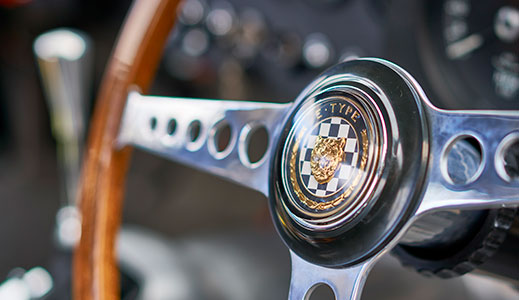Why Le Mans Matters to Jaguar
In the 1950s, a resurgent Jaguar needed to prove the speed
and reliability of its cars. The best way was to compete in - and win - the
toughest race of all, the Le Mans 24 Hours. In the end, Jaguar won seven times,
and developed technology that would transform sports car performance,
ultimately spawning the Jaguar E-type.

1951
Jaguar founder William Lyons knew success at Le Mans could radically change perception of Jaguar, as it had for Bentley in the 1920s. After a promising debut with the XK120 in 1950, Jaguar created a lighter, streamlined XK120C for 1951 - known as the C-type, for 'competition'. Its pace gave Peter Walker and Peter Whitehead a shot at victory, but there were concerns about reliability. Jaguar race manager Frank 'Lofty' England held out 'SLOW' signs, but someone persuaded Lyons the 45-minute lead wasn't enough, and he ordered England to post 'FASTER'. England did, but: "in a way Walker couldn't see from the car". As Lyons tracked lap times, he questioned whether Walker was following orders. "I showed 'FASTER' when Lyons was looking, 'SLOW' when he wasn't," said England. "Poor Walker got confused, so I gave Whitehead a stopwatch and told him to keep to a certain time and ignore all signals." The victory transformed Jaguar's international reputation. "After the war, Jaguar - as a car outside Britain - wasn't well known," said England. "By winning Le Mans, we established a reputation worth having."
1953
After 1951, Jaguar developed a pioneering disc brake technology with Dunlop. The brakes were used in the 1952 Mille Miglia, but driver Stirling Moss was concerned by the speed of the Mercedes. Jaguar redesigned the C-type with a smaller radiator that was more aerodynamic, but the car overheated in the 1952 Le Mans. A win for Moss in the 1952 Reims Grand Prix proved disc brakes' potential, and they were combined with a revised C-type that was 60kg lighter and 22bhp more powerful for 1953. Confusion over rules in practice, however, resulted in drivers Duncan Hamilton and Tony Rolt being excluded. Not expecting to race, they stayed up all night and were surprised when Lyons said he had paid a fine for the infringement. "It was 10am," Hamilton wrote. "Neither of us had slept, and 24 hours' racing lay ahead. We ordered black coffee, and asked if there was a Turkish bath in town." In the race, Rolt and Hamilton dominated, covering 304 laps (2,555 miles) at an average 106.46mph - the first time the 100mph mark was broken.
"The disc brakes were a great advantage," said Hamilton. "We knew they'd last 24 hours without being nursed. Other drivers had the problems of fade and wear, and had to overwork their transmission and gearbox to conserve their brakes. When all cars depend on drum brakes, the problem is a common one. In 1953, we Jaguar drivers no longer shared the common problem."
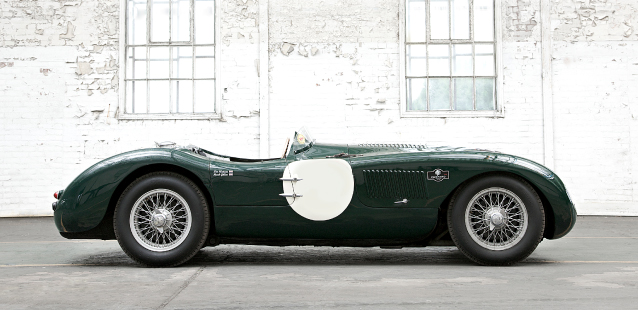
1955
For 1955, Jaguar faced increased competition from reigning champion Ferrari, the brand-new Mercedes 300 SLR, Aston Martin and Maserati. If ever there was a time to win Le Mans, this was it. Jaguar's new D-type had missed a win in the 1954 Le Mans, but was heavily revised for 1955 with a more streamlined body and an XK engine that now developed 270bhp. The mood within Jaguar was subdued, though. John Lyons - the Jaguar founder's only son - had been killed in a road accident on the way to the circuit, but Lyons insisted the team race on. In the early stages, Jaguar driver Mike Hawthorn led the charge against Ferrari and Mercedes. At 6:30pm, though, an accident launched Mercedes driver Pierre Levegh's car into the crowd opposite the pit lane. Around 120 people were injured and 84 - including Levegh - were killed. Opting not to cause a panic that would hinder the rescue process, officials let the race go on. Mercedes eventually withdrew from the race, handing victory to Jaguar drivers Hawthorn and Ivor Bueb, but the team refused to publicise its victory.
1956
Jaguar started to sell its D-type to private teams, as it prepared to withdraw its factory squad. Road car sales were booming, which meant work at the Browns' Lane factory was focused on road cars, rather than racing. One of the first customers was Scottish team Ecurie Ecosse, set up by Edinburgh-based accountant and pub owner David Murray after retiring as a driver. A passionate Francophile, he gave his team a blue livery and an exotic name - Team Scotland, in French - that would play well on the continent. At Le Mans, Jaguar had three works D-types, alongside the Ecurie Ecosse car and one for Belgian team Equipe National Belge. The Le Mans circuit had been modified after 1955, but remained fast and challenging, and race day dawned wet. On the second lap, two works Jaguars were eliminated in the slippery conditions, while the third was delayed by a technical problem. After a tight overnight battle, though, Ecurie Ecosse drivers Ron Flockhart and Ninian Sanderson emerged a lap ahead of the Aston Martin of ex-Jaguar driver Stirling Moss and Peter Collins. It was proof that the D-type was still capable of winning Le Mans, whether run by the factory, or not.
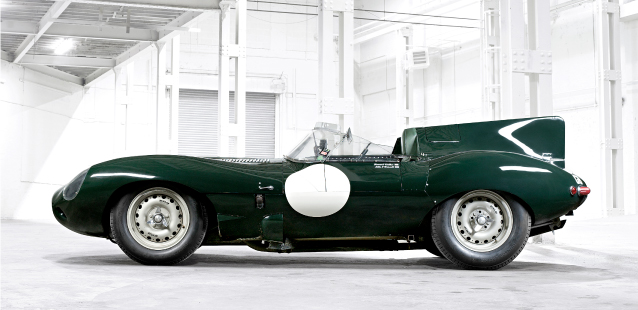
1957
Jaguar officially pulled out of Le Mans for 1957. The original plan was to develop a D-type replacement, but booming road car sales, the need to develop a new sports car and the Brown's Lane fire of February 1957 stymied Jaguar's return. Ferrari and Maserati had new cars for the 1957 Le Mans that were fast, but fragile, and the Italian teams retired early on. That left Jaguar's customer teams in charge. By the chequered flag, Jaguars were first, second, third, fourth and sixth, with Ecurie Ecosse drivers Ron Flockhart and Ivor Bueb a full eight laps ahead of their nearest rival. This fifth win was the last hurrah for the D-type, and a fitting finale for Jaguar's 'golden era' that established a reputation for speed, reliability and success that would last until the 1980s. It also had a direct impact on the creation of the Jaguar E-type, with ideas such as the monocoque construction, the XK engine, race-bred suspension and disc brakes all making their way into what would become Jaguar's most iconic sportscar.
1988
In the 1980s, Jaguar hit a slump. As chief executive John Egan worked to restore Jaguar's reputation, victory at Le Mans provided an instant hit of feel-good factor. In 1987, Jaguar had won the World Sportscar Championship, but the real prize was Le Mans. An all-new XJR-9 was built, with a 7.0-litre V12 and a low-drag aerodynamic package. The 1988 race was one of the last on the 'old' La Sarthe layout, with its 3.6-mile straight from Tertre Rouge to Mulsanne. Calling it a 'straight', though, is a misnomer. "The Mulsanne Straight is a public road - a Route Nationale - with trees, cafe?s, houses, and telegraph poles," Jaguar driver Martin Brundle said. "Trucks run down it, and produce tramlines in the road. This is where we're flat-out for more than a minute at 200mph. It scared the hell out of me. Then there's the Mulsanne kink. It's not a kink, it's a bloody corner. But the Jaguars felt totally at home there. It was like riding a bike - when you've done it once, it seems easy thereafter." In the race, Jaguar drivers Jan Lammers, Johnny Dumfries and Andy Wallace emerged in the lead. "As the chassis handled so well, we could run less wing than other cars," said Lammers. "We were absolutely flying - reaching 242mph on the Mulsanne Straight." Then it started to rain. As John Egan admitted: "The last few hours were torture." Jaguar ultimately finished 2m36s ahead of Porsche - the first time the German marque had been beaten at Le Mans since 1980. Jaguar's race distance of 394 laps (3,313 miles) was just shy of the 1971 record of 397 laps, and would not be beaten until 2010. "We knew it would be a hard race, but didn't think it would be that hard," said team boss Tom Walkinshaw. "We expected to cover 395 laps, and did 394. If it hadn't rained on Sunday morning, we'd probably have beaten the 397-lap record."
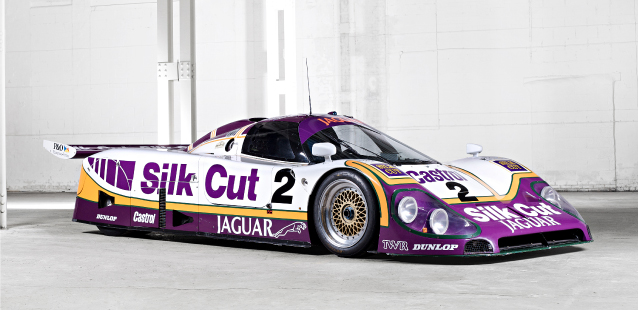
1990
After missing victory in 1989, Jaguar faced tough competition from Mercedes-Benz, Porsche, Mazda, Nissan and Toyota in 1990. Another challenge was the introduction of two chicanes interrupting the 3.6-mile run from Tertre Rouge to Mulsanne, placing focus on acceleration and handling, as well as outright speed. Jaguar's XJR-12LM was an update of the XJR-9 from 1988, and was powered by the same 750bhp 7.0-litre V12. Rising Formula 1 star Martin Brundle started the race with fellow Brit David Leslie and Frenchman Alain Ferte?. After their car hit trouble, though, Brundle was swapped to partner John Nielsen and David Cobb - the likely victory contenders. As dawn broke and the race entered its final six hours, Jaguar lost fourth gear - key to a fast lap time. "Le Mans is mainly fourth and fifth-gear corners, so it was difficult to get our lap-times," said Cobb. "It was possible, but damn hard." By the chequered flag, the Jaguar XJR-12 of Nielsen, Brundle and Cobb held its advantage, four laps ahead of the sister Jaguar of Jan Lammers, Andy Wallace and Franz Konrad, and seven laps ahead of the Porsches. A fitting finale to Jaguar's time at Le Mans.
Discover More
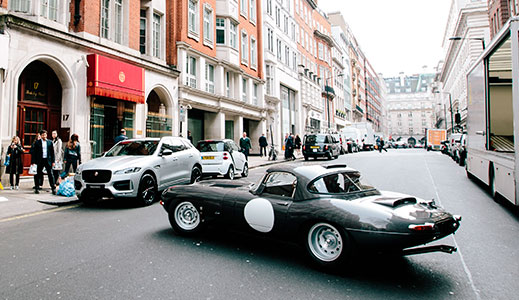
A New Home In Mayfair London
The Jaguar Lightweight E-type arrives at Stratstone's London showroom
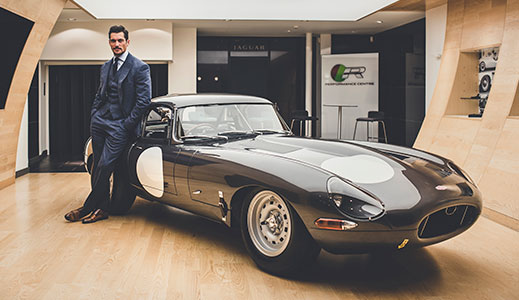
David Gandy Visits the E-type
Britain's leading male model talks about his passion for style and cars
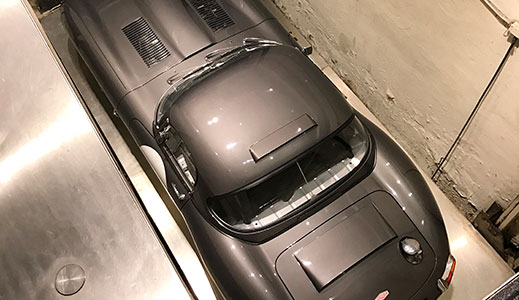
Exclusive Appearance in Mayfair
YouTube influencer and car enthusiast Shmee150 visits the Lightweight E-type

